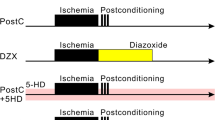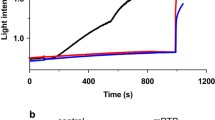Abstract
Inhibition of the mitochondrial KATP (mitoKATP) channel abrogates the beneficial effects of preconditioning induced by a brief episode of sublethal ischemia. We studied the effect of 5-hydroxydecanoate, a well-known inhibitor of the mitoKATP channel, on swelling of isolated liver and brain mitochondria. Volume changes were determined by measurement of light absorbance at 540 nm. Mitochondrial swelling induced by adding Ca2+ ions correlated with opening of the permeability transition pore as shown by modulation by 1 μM cyclosporin A. In brain mitochondria, 5-hydroxydecanoate did not significantly affect Ca2+-induced swelling. In contrast, 50 or 500 μM 5-hydroxydecanoate increased swelling of liver mitochondria by 9.7 ± 5.1% (n = 6, P = 0.057) and 29.4 ± 1.4% (n = 5, P < 0.0001), respectively. The effect of 5-hydroxydecanoate was blocked by cyclosporin A and was dependent on the presence of potassium in the medium. In medium containing 200 μM ATP to inhibit the mitoKATP channel, 5–hydroxydecanoate did not further increase Ca2+-induced swelling. We conclude that inhibition of the mitoKATP channel exerts its detrimental effect by facilitation of permeability transition pore opening.


Similar content being viewed by others
References
Bajgar R, Seetharaman S, Kowaltowski AJ, Garlid KD, Paucek P (2001) Identification and properties of a novel intracellular (mitochondrial) ATP-sensitive potassium channel in brain. J Biol Chem 276:33369–33374
Bambrick LL, Chandrasekaran K, Mehrabian Z, Wright C, Krueger BK, Fiskum G (2006) Cyclosporin A increases mitochondrial calcium uptake capacity in cortical astrocytes but not cerebellar granule neurons. J Bioenerg Biomembr 38:43–47
Bernardi P (1992) Modulation of the mitochondrial cyclosporin A-sensitive permeability transition pore by the proton electrochemical gradient. Evidence that the pore can be opened by membrane depolarization. J Biol Chem 267:8834–8839
Brustovetsky N, Dubinsky JM (2000) Limitations of cyclosporin A inhibition of the permeability transition in CNS mitochondria. J Neurosci 20:8229–8237
Chinopoulos C, Starkov AA, Fiskum G (2003) Cyclosporin A-insensitive permeability transition in brain mitochondria: Inhibition by 2-aminoethoxydiphenyl borate. J Biol Chem 278:27382–27389
Costa AD, Jakob R, Costa CL, Andrukhiv K, West IC, Garlid KD (2006) The mechanism by which the mitochondrial ATP-sensitive K+ channel opening and H2O2 inhibit the mitochondrial permeability transition. J Biol Chem 281:20801–20808
Crompton M (1999) The mitochondrial permeability transition pore and its role in cell death. Biochem J 341(pt 2):233–249
Dahlem YA, Wolf G, Siemen D, Horn TF (2006) Combined modulation of the mitochondrial ATP-dependent potassium channel and the permeability transition pore causes prolongation of the biphasic calcium dynamics. Cell Calcium 39:387–400
Facundo HT, de Paula JG, Kowaltowski AJ (2005) Mitochondrial ATP-sensitive K+ channels prevent oxidative stress, permeability transition and cell death. J Bioenerg Biomembr 37:75–82
Garcia de Arriba S, Franke H, Pissarek M, Nieber K, Illes P (1999) Neuroprotection by ATP-dependent potassium channels in rat neocortical brain slices during hypoxia. Neurosci Lett 273:13–16
Garlid KD, Paucek P (2003) Mitochondrial potassium transport: The K+ cycle. Biochim Biophys Acta 1606:23–41
Gross GJ, Auchampach JA (1992) Blockade of ATP-sensitive potassium channels prevents myocardial preconditioning in dogs. Circ Res 70:223–233
Gulbins E, Dreschers S, Bock J (2003) Role of mitochondria in apoptosis. Exp Physiol 88:85–90
Halestrap AP (1991) Calcium-dependent opening of a non-specific pore in the mitochondrial inner membrane is inhibited at pH values below 7. Implications for the protective effect of low pH against chemical and hypoxic cell damage. Biochem J 278(pt 3):715–719
Halestrap AP, Woodfield KY, Connern CP (1997) Oxidative stress, thiol reagents, and membrane potential modulate the mitochondrial permeability transition by affecting nucleotide binding to the adenine nucleotide translocase. J Biol Chem 272:3346–3354
Hanley PJ, Daut J (2005) KATP channels and preconditioning: A re-examination of the role of mitochondrial KATP channels and an overview of alternative mechanisms. J Mol Cell Cardiol 39:17–50
Hanley PJ, Drose S, Brandt U, Lareau RA, Banerjee AL, Srivastava DK, Banaszak LJ, Barycki JJ, Van Veldhoven PP, Daut J (2005) 5-Hydroxydecanoate is metabolised in mitochondria and creates a rate-limiting bottleneck for beta-oxidation of fatty acids. J Physiol 562:307–318
Hanley PJ, Mickel M, Loffler M, Brandt U, Daut J (2002) KATP channel-independent targets of diazoxide and 5-hydroxydecanoate in the heart. J Physiol 542:735–741
Hunter DR, Haworth RA, Southard JH (1976) Relationship between configuration, function, and permeability in calcium-treated mitochondria. J Biol Chem 251:5069–5077
Inoue I, Nagase H, Kishi K, Higuti T (1991) ATP-sensitive K+ channel in the mitochondrial inner membrane. Nature 352:244–247
Kristal BS, Dubinsky JM (1997) Mitochondrial permeability transition in the central nervous system: Induction by calcium cycling-dependent and -independent pathways. J Neurochem 69:524–538
O’Rourke B (2004) Evidence for mitochondrial K+ channels and their role in cardioprotection. Circ Res 94:420–432
Paucek P, Mironova G, Mahdi F, Beavis AD, Woldegiorgis G, Garlid KD (1992) Reconstitution and partial purification of the glibenclamide-sensitive, ATP-dependent K+ channel from rat liver and beef heart mitochondria. J Biol Chem 267:26062–26069
Skalska J, Debska G, Kunz WS, Szewczyk A (2005) Antidiabetic sulphonylureas activate mitochondrial permeability transition in rat skeletal muscle. Br J Pharmacol 145:785–791
Szewczyk A, Wojcik G, Nalecz MJ (1995) Potassium channel opener, RP 66471, induces membrane depolarization of rat liver mitochondria. Biochem Biophys Res Commun 207:126–132
Author information
Authors and Affiliations
Corresponding author
Rights and permissions
About this article
Cite this article
Kupsch, K., Parvez, S., Siemen, D. et al. Modulation of the Permeability Transition Pore by Inhibition of the Mitochondrial KATP Channel in Liver vs. Brain Mitochondria. J Membrane Biol 215, 69–74 (2007). https://doi.org/10.1007/s00232-007-9006-3
Received:
Accepted:
Published:
Issue Date:
DOI: https://doi.org/10.1007/s00232-007-9006-3




